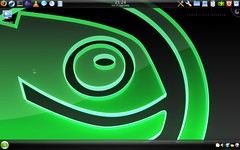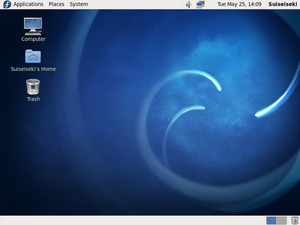 opensuse (Photo credit: BasterBy)
opensuse (Photo credit: BasterBy)
I decided to give Opensuse a try again and not let Mr. Linus deter me from giving it a fair chance. Why I decided to use this particular distro? Simply a fear of failed upgrades. In the pass two weeks I have had to nurse two systems after having convinced people to try Ubuntu. The upgrade process between versions of Ubuntu have left me in pain before, and it was unfortunate that I couldn't save them. I realize a couple days too late that the 12.04 release had come, mainly because I was not looking out for it. By the time I realized this it was too late to save my friends.
After whatever telephone support I could have given to get them back up and running again (fortunately not critical data loss due to separate home partitioning) I decided to look into a rolling release distro.
The most popular rolling release it would seem was Arch Linux. The concept of build our own Linux was very appealing, but after looking at a few YouTube videos I thought to myself, this is complicated for me far more a new Linux baby. The most popular derivative of Arch was probably Chakra. It is a bit more restricted but apparently more stable and comes with and remains with the Kde desktop. This was a downside to me since I had bad experiences with it in the past. On the other hand ,"what is Linux without options"?
My second look was a Sabayon. It was high in the distrowatch board and based on Gentoo, another true rolling release distro. I will say that the unfortunate thing about Sabayon is that it did not work in my virtual machine, and I didn't have a system to install it on. My problem here was that I couldn't recommend it if I did not use it.
This brought me to Opensuse. This distro I have used before and found to be stable. There is a variety of desktops and lots of applications. Getting the basic replacement desktop according to the HowToForge guide was not that hard and is easy enough to confidently recommend to a new user. Well, since Opensuse usability is good we now have the issue of upgrades.
Opensuse release cycle is every 8 months and upgrades are usually done by running the DVD. The DVD upgrade is smooth and painless but still leaves me with the responsibility of knowing that my friends can boot from the DVD drive. On the other hand I could set up the tumbleweed repositories for them and just let them do all there updates themselves. The only time i might get a call is when they need to know what alternate they need to install for what they had on windows.
I also found a great site for the opensuse beginner here that should be all that anyone that has basic needs for there pc.
After whatever telephone support I could have given to get them back up and running again (fortunately not critical data loss due to separate home partitioning) I decided to look into a rolling release distro.
The most popular rolling release it would seem was Arch Linux. The concept of build our own Linux was very appealing, but after looking at a few YouTube videos I thought to myself, this is complicated for me far more a new Linux baby. The most popular derivative of Arch was probably Chakra. It is a bit more restricted but apparently more stable and comes with and remains with the Kde desktop. This was a downside to me since I had bad experiences with it in the past. On the other hand ,"what is Linux without options"?
My second look was a Sabayon. It was high in the distrowatch board and based on Gentoo, another true rolling release distro. I will say that the unfortunate thing about Sabayon is that it did not work in my virtual machine, and I didn't have a system to install it on. My problem here was that I couldn't recommend it if I did not use it.
This brought me to Opensuse. This distro I have used before and found to be stable. There is a variety of desktops and lots of applications. Getting the basic replacement desktop according to the HowToForge guide was not that hard and is easy enough to confidently recommend to a new user. Well, since Opensuse usability is good we now have the issue of upgrades.
Opensuse release cycle is every 8 months and upgrades are usually done by running the DVD. The DVD upgrade is smooth and painless but still leaves me with the responsibility of knowing that my friends can boot from the DVD drive. On the other hand I could set up the tumbleweed repositories for them and just let them do all there updates themselves. The only time i might get a call is when they need to know what alternate they need to install for what they had on windows.
I also found a great site for the opensuse beginner here that should be all that anyone that has basic needs for there pc.







